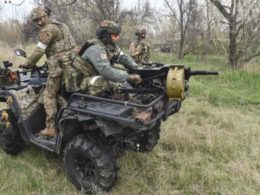Today there are a lot of updates from the Kursk direction.
Here, a new chapter in drone warfare is unfolding in the rapidly evolving battlefield of the Kursk incursion.
Ukrainian forces are pushing the limits of innovation, deploying FPV drones to counter the persistent threat of Russian reconnaissance UAVs. The result is a tense and high-stakes clash in the skies that could redefine modern air defense tactics.
Ukrainian forces advance near Sudzha
Ukrainian forces are making significant strides in the Kursk region, with a particular focus on the strategically important area around Sudzha.
Sudzha has become a key logistical hub for Ukrainian operations in the region, central to their broader offensive strategy. Securing this area is essential, not only to sustain vital supply lines but also to keep the front line at a safe distance, reducing the threat of artillery, drone, and missile strikes from Russian forces.
In recent days, Ukrainian forces have maintained their southeastward push from Sudzha, though progress has slowed as they encounter increasingly fortified Russian defenses.
Conflicting reports from both sides point to a highly fluid battlefront, with control of key positions frequently shifting. Nevertheless, it is confirmed that Ukrainian forces have secured all settlements south of Sudzha up to the border and are advancing towards Belitsa and Giri along multiple fronts.
The geography of the region poses substantial challenges for advancing forces. The area north of the Psel River is densely wooded, with the river's numerous meanders creating a complex and difficult terrain to navigate.

Russian fortifications are entrenched along the edges of these forests, providing them with a strong defensive position that significantly impedes Ukrainian progress.
Compounding the difficulty, the primary road in this region runs along the Sudzha-Ulanok-Belitsa axis, just north of the forested area. Ukrainian advances along the southeastern front heavily depend on this road as the main supply route, making its control crucial for maintaining the momentum of the offensive.
Ukrainian forces are advancing on multiple fronts. One front is pushing eastward, north of the road from Ulanok, while another is progressing south of the Psel River, targeting the breach of Russian fortifications near Kanyshnoye.
A third axis of advance has been reported further south, near Ozerki. If successful, these coordinated maneuvers could encircle Russian forces, bringing the Belitsa and Giri areas under Ukrainian control.

This would not only facilitate further advances from these strategic locations but also alleviate pressure on Sudzha, securing a stronger foothold in the region.
On the northern vector, Ukrainian forces are reportedly advancing beyond Ulanok, though full control of the locality has yet to be definitively confirmed.
South of the Psel River, geolocated footage has verified Russian FPV drone strikes on Ukrainian positions in Plekhovo and Borki, confirming Ukrainian control of these settlements. Similar attacks have been documented in Spalnoie, further validating Ukrainian presence there. The most intense fighting is currently reported near Krupets, just beyond Spalnoie.
Ukraine uses FPV drones to counter Russian reconnaissance UAVs
The analysis of Russian drone strike footage underscores the widespread use of reconnaissance drones in coordinating their attack systems. The integration of these drones into Russian targeting operations has prompted Ukraine to intensify its efforts in developing innovative countermeasures.
In response to the increasing threat from Russian reconnaissance drones, Ukrainian forces have significantly accelerated their deployment of FPV drones within integrated systems designed to intercept and neutralize these aerial threats. The use of FPV drones for drone-on-drone interception has emerged as a cost-effective and practical approach to modern drone warfare.
Trending Now
Recent technological advancements, such as machine vision systems and lidar-triggered detonators, have been pivotal in enhancing the effectiveness of FPV drones as interceptors. However, the success of these systems relies on the seamless integration of radar detection with FPV drone teams, presenting a complex yet essential challenge for contemporary air defense.
Despite these obstacles, Ukrainian forces have successfully begun utilizing FPV drones to intercept enemy UAVs, marking a significant evolution in drone warfare tactics.

FPV drone interceptors hold significant potential for protecting valuable assets from enemy reconnaissance UAVs, which often direct strikes against critical infrastructure. Although FPV drones offer a promising and cost-effective alternative to traditional air defense systems, their development is still in its early stages.
To fully realize their potential, these drones will need further integration with radar and other support systems, ensuring a more comprehensive and effective defense strategy.
Fortunately for Ukrainian forces, the disarray and fragmentation within Russian ranks on the Kursk front have unintentionally benefited Ukraine's efforts to neutralize Russian reconnaissance drones.
Friendly fire among Russian troops
Russian soldiers, in their attempts to counter Ukrainian UAVs, have begun experimenting with FPV drones, which has led to instances of friendly fire, further complicating their own operations.
Reports have emerged on social media showing Russian soldiers celebrating after their Mavic 3 drone successfully downed what they believed to be an enemy UAV, only to later discover it was a valuable Russian Zala 421.
This incident highlights the ongoing dysfunction and lack of coordination among the disparate Russian forces attempting to contain the Ukrainian advance in the Kursk region.
Overall, Ukrainian forces continue to advance on multiple fronts in the Kursk region, with a key focus on the southeastern push toward capturing Belitsa and Giri.
Despite facing limited anti-aircraft support from Western allies, Ukraine is innovating by integrating FPV drones into systems designed to counter Russian reconnaissance drones.
Success in this area could significantly undermine Russian strike capabilities, many of which already suffer from precision limitations. Additionally, the ongoing disarray among Russian forces, compounded by their struggles in drone warfare, is creating opportunities for Ukraine to further advance and consolidate control over contested territories.
In our regular frontline report, we pair up with the military blogger Reporting from Ukraine to keep you informed about what is happening on the battlefield in the Russo-Ukrainian war.





